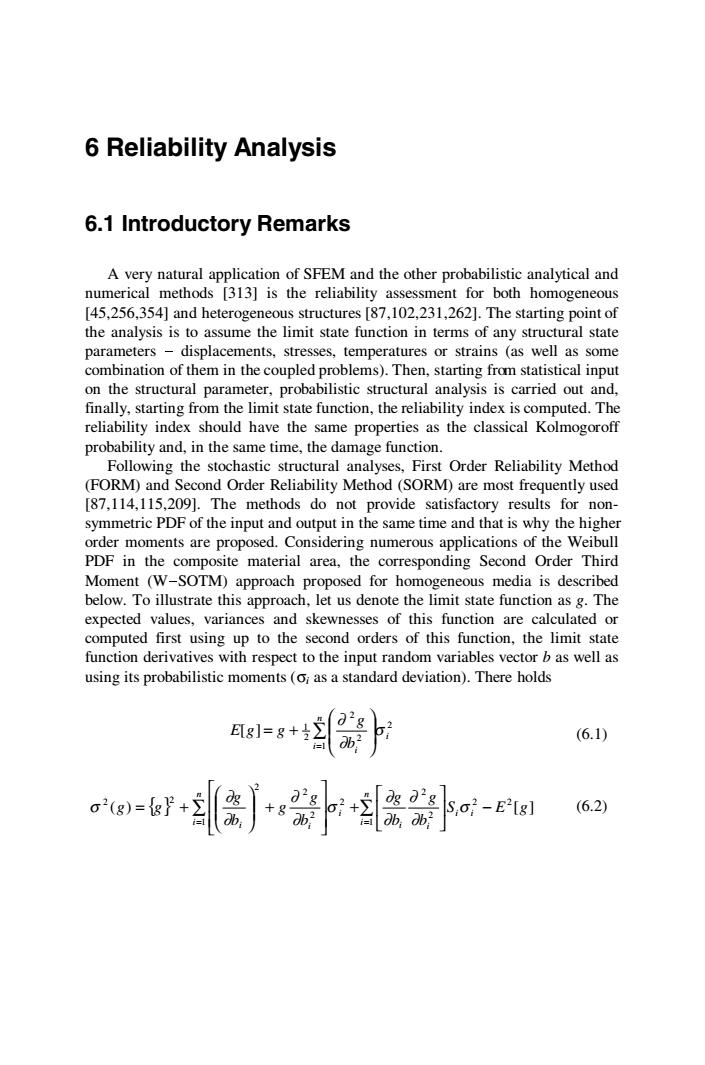正在加载图片...

6 Reliability Analysis 6.1 Introductory Remarks A very natural application of SFEM and the other probabilistic analytical and numerical methods [313]is the reliability assessment for both homogeneous [45,256,354]and heterogeneous structures [87,102,231,262].The starting point of the analysis is to assume the limit state function in terms of any structural state parameters -displacements,stresses,temperatures or strains (as well as some combination of them in the coupled problems).Then,starting from statistical input on the structural parameter,probabilistic structural analysis is carried out and, finally,starting from the limit state function,the reliability index is computed.The reliability index should have the same properties as the classical Kolmogoroff probability and,in the same time,the damage function. Following the stochastic structural analyses,First Order Reliability Method (FORM)and Second Order Reliability Method (SORM)are most frequently used [87,114,115,209].The methods do not provide satisfactory results for non- symmetric PDF of the input and output in the same time and that is why the higher order moments are proposed.Considering numerous applications of the Weibull PDF in the composite material area,the corresponding Second Order Third Moment (W-SOTM)approach proposed for homogeneous media is described below.To illustrate this approach,let us denote the limit state function as g.The expected values,variances and skewnesses of this function are calculated or computed first using up to the second orders of this function,the limit state function derivatives with respect to the input random variables vector b as well as using its probabilistic moments(o;as a standard deviation).There holds ELg]=g+ 0b2 (6.1) a'(g)-s 到成-a (6.2)6 Reliability Analysis 6.1 Introductory Remarks A very natural application of SFEM and the other probabilistic analytical and numerical methods [313] is the reliability assessment for both homogeneous [45,256,354] and heterogeneous structures [87,102,231,262]. The starting point of the analysis is to assume the limit state function in terms of any structural state parameters - displacements, stresses, temperatures or strains (as well as some combination of them in the coupled problems). Then, starting from statistical input on the structural parameter, probabilistic structural analysis is carried out and, finally, starting from the limit state function, the reliability index is computed. The reliability index should have the same properties as the classical Kolmogoroff probability and, in the same time, the damage function. Following the stochastic structural analyses, First Order Reliability Method (FORM) and Second Order Reliability Method (SORM) are most frequently used [87,114,115,209]. The methods do not provide satisfactory results for nonsymmetric PDF of the input and output in the same time and that is why the higher order moments are proposed. Considering numerous applications of the Weibull PDF in the composite material area, the corresponding Second Order Third Moment (W-SOTM) approach proposed for homogeneous media is described below. To illustrate this approach, let us denote the limit state function as g. The expected values, variances and skewnesses of this function are calculated or computed first using up to the second orders of this function, the limit state function derivatives with respect to the input random variables vector b as well as using its probabilistic moments (σi as a standard deviation). There holds ∑ = ⎟ ⎟ ⎠ ⎞ ⎜ ⎜ ⎝ ⎛ = + n i i i b g E g g 1 2 2 2 2 1 [ ] σ ∂ ∂ (6.1) { } ∑ ∑ = = ⎥ − ⎦ ⎤ ⎢ ⎣ ⎡ + ⎥ ⎥ ⎦ ⎤ ⎢ ⎢ ⎣ ⎡ + ⎟ ⎟ ⎠ ⎞ ⎜ ⎜ ⎝ ⎛ = + n i i i i i n i i i i S E g b g b g b g g b g g g 1 2 2 2 2 1 2 2 2 2 2 2 ( ) σ [ ] ∂ ∂ ∂ ∂ σ ∂ ∂ ∂ ∂ σ (6.2)